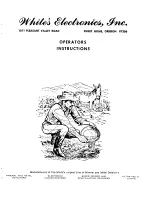
should begin with research some time before the day of the actual search. The extent and
thoroughness of your research will be one of the major factors in the success of your detecting.
You should aim to get as complete an understanding as possible of the local history and
geography. The key to the choice of site is to think of people, where they congregated over the
past few hundred years. What were their customs and pursuits? Where did they spend money?
Where did they carry money? The answers are not Roman sites, nor are they associated with
mystic treasure stories of crocks of gold. Rather, they are unassuming, undramatic places, like
public footpaths and ancient rights of way, old houses and so on.
When you have chosen your site, allocate a whole day from early morning to early evening for
the search. Make sure you have all the equipment you are likely to need. Your detector should be
checked before starting out, and you should always carry a spare set of batteries. You will also
need a strong, sharp trowel. It is also a good idea to have a set of lines and pins so that you can
lay out your search area scientifically.
Most beginners make the mistake of rushing about hoping to chance upon a rare find. If for
example there happened to be a valuable ring that was buried 4" deep on the site you were
searching, if you rushed about haphazardly and quickly on the site, the odds would be very much
against you finding it. On the other hand, if you pegged out the area scientifically and searched
slowly and thoroughly, the odds of finding the ring would be very much more in your favour.
Remember, BE PATIENT and WORK SLOWLY. Do not try to cover too large an area, restrict
yourself to a small area and work through it thoroughly. Make a note of the position and the
extent of the area, and then when you return you can start again further on without missing any
ground or covering the same area twice. It is also important to keep the detector head as close to
the ground as possible. Ideally, you should 'iron' the ground with the search head of the detector,
so that you do not lose any detection range. Similarly, if you work slowly and carefully you
should be able to distinguish the faint signals as well as the clear-cut signals and further increase
your finds.
Search Head Position
A
B
C
D
It is essential that the search head is kept close and parallel to the ground as in B. Do not hold the
search head too high above the ground, or at an odd angle as in A, C, D as you will be apt to
miss finds.
The technique of getting the best out of your detector is not learnt overnight. You need to get as
much experience as possible so that you can recognise every kind of signal. Indeed, a good
detector operator can often tell you what is being detected before it is unearthed.
9






























